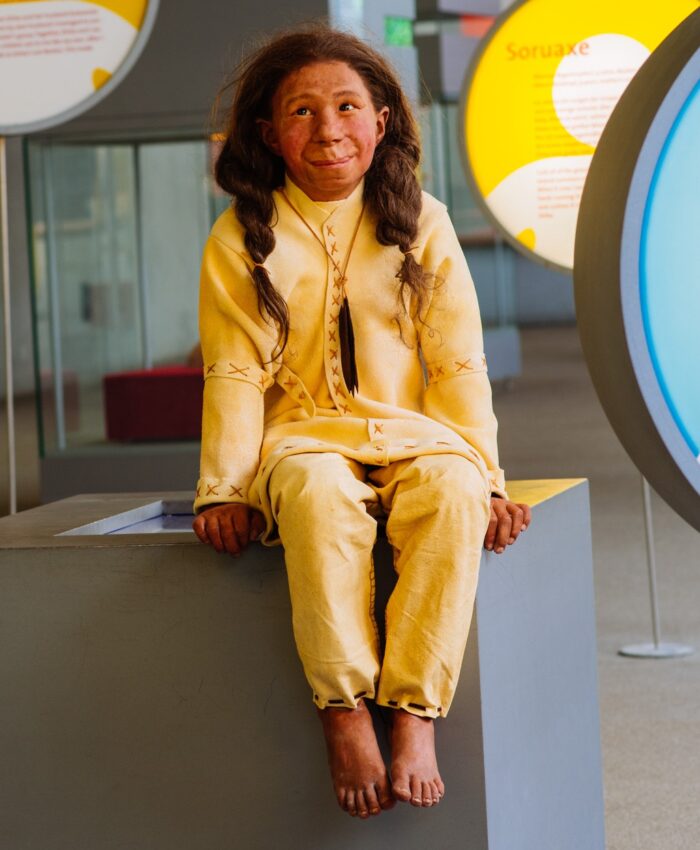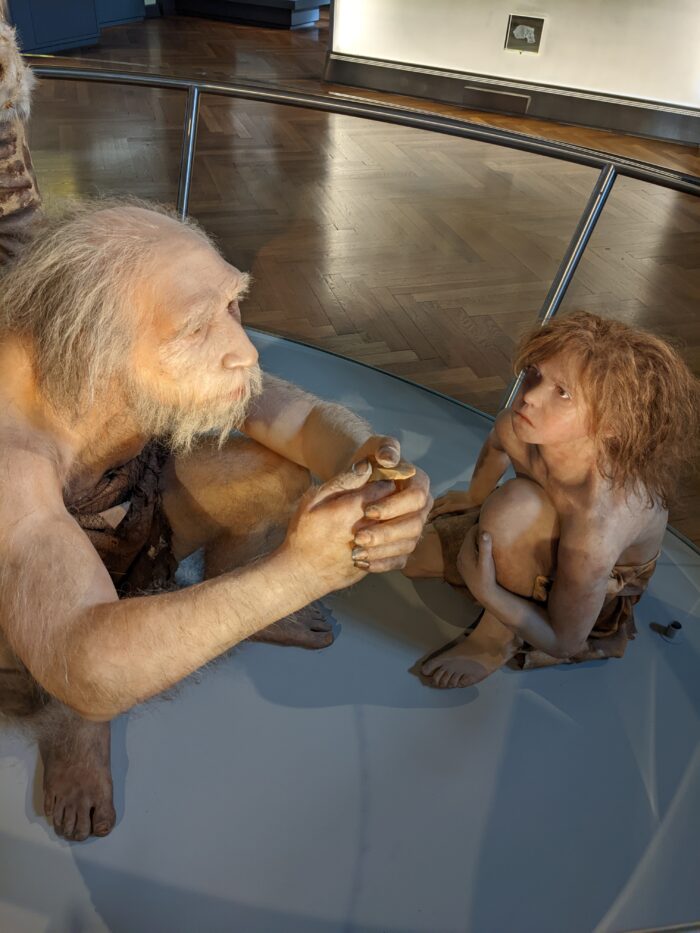What other types of humans have been out there?
Homo florensis
Homo florensis, for example, was a very small human. They reached a height of about one metre / 3.3 ft in adulthood. They still populated the Indonesian islands 60,000 years ago.1
Their reduced body size is likely a direct result of being an isolated human population on an island for a long time. When a population’s range is limited to a small habitat, primarily on islands, so-called insular dwarfism may occur. On islands, the food resources periodically decline to a bare minimum. And as smaller animals need fewer resources, they are better suited to these conditions. That’s why larger mammals tend to develop smaller bodies on islands over time.
We found their tools and other artefacts.2
Homo neanderthalensis
The Neanderthals, on the other hand, were stronger than us.3 Due to less hair, they were probably the first humans who had to put on clothes.4

They also used fire. And they created art on cave walls long before we even reached these areas in Europe.5 Further, they aesthetically carved patterns in bones.6 Some Neanderthals painted their bodies and decorated themselves with bird feathers.7 Brush sets and ochre remains have been found in many places.8
Others produced birch pitch, probably the first glue known to humankind. They used it to glue stone blades into wooden sticks.9

With their spears, they hunted bison and huge forest elephants in teams.10
Many finds document the healing of broken bones and the survival of people of great age, sometimes with severe medical conditions.11 Funerary objects and particularly decorated clothing of the dead indicate the presence of ideas about an afterlife.12 — Did they already have a belief about ending up in heaven as some religious people do nowadays?
Anyway, all these are clear signs of civilisation. In other words: they too had a distinct, early culture and were by no means cognitively inferior, as they have long been wrongly portrayed. I really wonder what their songs and singing sounded like?

The skin colour of the reconstructions above from Vienna Natural History Museum, however, should be somewhat darker. Recent studies suggest that humans only began to develop really light skin about 7,000 years ago. Projection and racially biased thinking exist in science, too. The famous Mister N. from the Neanderthal Museum in Germany, from the first place of discovery, has already been corrected in this respect.13

The first discovery site is something special. It caused a sensation: Because the description of the Neandertal 1 bones as fossil human later provided evidence for the validity of Darwin’s theory of evolution concerning us, the Homo sapiens. Darwin’s theory of evolution says that living beings change over time to become better suited to their environment. Before, people and even scientists believed that all living beings were created just as they are now and that they never changed. Probably that’s why the workers who found the bones initially thought they belonged to a cave bear.

Instead, the description of the bones as belonging to a prehistoric human triggered great discussions about the age of mankind.14 Ultimately, the biblical 6,000 years were up for debate. That was the accepted age of humanity at that time.15 Johann Carl Fuhlrott was the first to examine the bones in 1856.16 In a lecture published in 1865, he already assumed at least 100,000 years of human history.17 In doing so, Fuhlrott was already clearly moving in the right direction, as we know it today.
The Neanderthals in us
Until about 28,000 years ago, Neanderthals still populated our planet. That was not long ago at all! Contact and relationships between them and Homo sapiens also occurred here and there.18 In fact, almost half of the Homo sapiens living today still carry small remains of Homo neanderthalensis DNA.19
DNA is a name for the extremely tiny building blocks of life. It’s like a set of special LEGO bricks that carry instructions for building and running every living being, just like how LEGO instructions help you build different models. It’s a code that tells our bodies how to grow, what colour our hair is, and even what makes us unique. As you are the child of our parents, your DNA contains building blocks from both of them. If now your great-great-great-grandmother was Neanderthal, a tiny part of you would still consist of her Neanderthal building blocks today.
Now, have a a look around you. Who could possibly still carry parts of Neanderthal DNA? Maybe your friend does? Probably the neighbour’s child? You mom? You? Well, you can’t really tell from outward appearances.20 Perhaps some people with a relatively high amount still have parts of the characteristic Neanderthal over-eye bulge (Torus supraorbitalis) which you can feel when you touch the area above the eyebrows. I do, for example. But in principle you need a genetic laboratory to look into ones genetic make-up. — In my case, I carry 2 % Homo neanderthalensis DNA in my body.21
Homo denisova
Homo denisova is the Asian sibling of the European Neanderthal, if you want. They also lived in own populations as recently as 30,000 years ago.22
Researchers discovered a beautiful bracelet and a ring carved out of marble in a Denisova cave in the Altai Mountains of Siberia. With an age of around 40,000 years, they are one of the oldest examples of prehistoric jewellery that we know today.23
Homo denisova too mixed with other kinds of the human species.24
What a beautiful variety of ancient kinds of humans, just to name a few examples!
Reasons for their disappearance
But it was very likely not a love story everywhere. Because the other types of humans no longer exist in own populations. Whether our ancestors always fought with them or whether it was a combination of other reasons that caused the other kinds of humans to disappear, we don’t know exactly.25 What is striking, however, is that wherever Homo sapiens groups began to appear, the populations of the other humans disappeared some time later.26
Continue with Homo sapiens…
Footnotes / further reading
- Sutikna, T., et al.: Revised stratigraphy and chronology for Homo floresiensis at Liang Bua in Indonesia. In: Nature. Vol. 532, 2016, No. 7599, p. 366–369.
- Roberts, A., et al.: Evolution. The Human Story. London: DK Dorling Kindersley, 2023, p. 140-147.
- Johanson, D., Edgar, B.: Lucy und ihre Kinder. Munich: Elsevier, 2006, p. 225-246.
- Johanson, D., Edgar, B.: Lucy und ihre Kinder. Munich: Elsevier, 2006, p. 99; Junker, T.: Die Evolution des Menschen. Munich: C. H. Beck, 2021, p. 78/79.
- Marquet, J.-D., et al.: The earliest unambiguous Neanderthal engravings on cave walls: La Roche-Cotard, Loire Valley, France. In: PLOS ONE (June 21, 2023). URL: https://journals.plos.org/plosone/article?id=10.1371/journal.pone.0286568. Retrieved July 25, 2023.
- Neandertaler im Harz verzierte Knochen bereits vor über 50.000 Jahren. In: Website University Kiel (July 05, 2021). URL: https://www.uni-kiel.de/de/detailansicht/news/153-grabung-einhornhoehle. Retrieved May 14, 2023.
- Finlayson, C., Brown, K., Blasco, R., Rosell, J., Negro, J. J., et al.: Birds of a Feather. Neanderthal Exploitation of Raptors and Corvids. In: PLOS ONE (October 12, 2012). URL: https://journals.plos.org/plosone/article?id=10.1371/journal.pone.0045927. Retrieved May 14, 2023.
- Werde Teil der Menschenfamilie. Mettmann: Neanderthal Museum, 2023, p. 72.
- Daley, J.: Making Neanderthal Birch Tar Isn’t as Complex as Thought. In: Smithsonian Magazine (August 26, 2019). URL: https://www.smithsonianmag.com/smart-news/making-neanderthal-birch-tar-isnt-complex-thought-180972994/. Retrieved May 14, 2023; Roberts, A., et al.: Evolution. The Human Story. London: DK Dorling Kindersley, 2023, p. 191.
- Jahn, A.: Stoßen statt werfen. In: Spektrum der Wissenschaft (November 24, 2002). URL: https://www.spektrum.de/news/stossen-statt-werfen/611824. Retrieved May 15, 2023. vs. Neue Studie zeigt: Neandertaler töteten auch auf große Distanz. In: Kreiszeitung (January 31, 2019). URL: https://www.kreiszeitung.de/lokales/niedersachsen/londoner-forscher-testen-nachbau-schoeninger-neandertaler-speere-krz-11621695.html. Retrieved May 15, 2023; Via, T.: Neandertaler jagten riesige Elefanten im heutigen Sachsen-Anhalt. In: MDR Wissen (March 2, 2023). https://www.mdr.de/wissen/geiseltalsee-neandertaler-jagten-waldelefanten-100.html. Retrieved June 20, 2023.
- Spikins, P., et al.: Living to fight another day. The ecological and evolutionary significance of Neanderthal healthcare. In: Quaternary Science Reviews. Volume 217, 08/2019, S. 98-118. URL: https://www.sciencedirect.com/science/article/pii/S0277379118305389. Retrieved May 30, 2023.
- Werde Teil der Menschenfamilie. Mettmann: Neanderthal Museum, 2023, p. 69.
- Museum in Mettmann. Neandertaler-Nachbildung bekommt dunklere Hautfarbe. In: T-Online (August 6, 2021). URL: https://www.t-online.de/nachrichten/wissen/archaeologie/id_90582702/neandertaler-nachbildung-in-mettmann-bekommt-dunklere-hautfarbe.html. Retrieved June 20, 2023.
- Narr, K. J., Weniger, G.-C.: Der Neanderthaler und sein Entdecker. Johann Carl Fuhlrott und die Forschungsgeschichte. Mettmann: Neanderthal Museum, 2023, p. 85-90.
- Werde Teil der Menschenfamilie. Mettmann: Stiftung Neanderthal Museum, 2023, p. 13.
- Elberfelder Newspaper, Nr. 212 (September 6, 1856); Fuhlrott, J. C.: Menschliche Überreste aus einer Felsengrotte des Düsselthals. In: Verhandlungen des naturhistorischen Vereines der preussischen Rheinlande, Ausgabe 16 (1859), p. 131-153, especially p. 136. URL: https://www.zobodat.at/pdf/Verh-nathist-Ver-preuss-Rheinlande_16_0131-0153.pdf. Retrieved June 29, 2023.
- Fuhlrott, J. C.: Der fossile Mensch aus dem Neanderthal und sein Verhältniß zum Alter des Menschengeschlechts. Duisburg, Verlag von W. Falk & Volmer, 1865, p. 9/10. URL: https://www.digitale-sammlungen.de/de/view/bsb10913311. Retrieved June 28, 2023.
- Osterkamp, J.: Letzter Neandertaler-Sex ist gar nicht lang her. In: Spektrum der Wissenschaft (May 12, 2015). URL: https://www.spektrum.de/news/letzter-neandertaler-sex-ist-gar-nicht-lang-her/1346165. Retrieved May 13, 2023.
- Around 40 % of Homo sapiens today. — Teague, R., McRae, R.: Ancient DNA and Neanderthals. In: Website Smithsonian National Museum of Natural History. URL: https://humanorigins.si.edu/evidence/genetics/ancient-dna-and-neanderthals. Retrieved May 18, 2023; Roberts, A., et al.: Evolution. The Human Story. London: DK, 2023, p. 190.
- Engeln, H. Wie uns die Gene der Neandertaler prägen. In: RiffReporter (January 22, 2021). URL: https://www.riffreporter.de/de/wissen/gene-neandertaler-homo-sapiens. Retrieved June 29, 2023.
- According to DNA test & analysis by Genelink, S.L. (Spain), June 20, 2023.
- Price, M.: Ancient DNA puts a face on the mysterious Denisovans, extinct cousins of Neanderthals. In: American Association for the Advancement of Science (September 19, 2019). URL: https://www.science.org/content/article/ancient-dna-puts-face-mysterious-denisovans-extinct-cousins-neanderthals. Retrieved May 14, 2023.
- Liesowska, A.: Stone bracelet is oldest ever found in the world. In: The Siberian Times (May 7, 2015). URL: https://siberiantimes.com/science/casestudy/features/f0100-stone-bracelet-is-oldest-ever-found-in-the-world/. Retrieved July 24, 2023.
- Wei-Haas, M.: You may have more Neanderthal DNA than you think. In: National Geographic (January 30, 2020). URL: https://www.nationalgeographic.com/science/article/more-neanderthal-dna-than-you-think. Retrieved May 14, 2023.
- Osterkamp, J.: Aktuelle Seite: Entwicklung der Menschheit. Starb der Neandertaler einfach so aus? In: Spektrum der Wissenschaft (November 28, 2019). URL: https://www.spektrum.de/news/starb-der-neandertaler-einfach-so-aus/1688798. Retrieved May 14, 2023.
- Johanson, D., Edgar, B.: Lucy und ihre Kinder. Munich: Elsevier, 2006, p. 56.